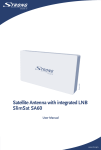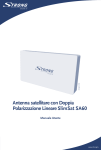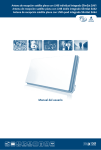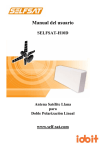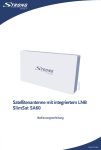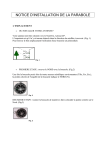Download Strong SlimSat SA64
Transcript
Picture sim ilar Satellite Antenna with integrated Single LNB SlimSat SA61 Satellite Antenna with integrated Twin LNB SlimSat SA62 Satellite antenna with integrated Quad LNB SlimSat SA64 User Manual PART 1 • English 1.0 What is SLIMSAT? 2 2.0 Safety Instructions 2 3.0 How to Install? 3.1 Step 1: Where to Install? 3.2 Step 2: Installation 3.3 Step 3: Connecting the Antenna and the Set top box 3.4 Step 4: Fine Tuning and Fixing the Bracket 3 3 4 6 6 4.0 Troubleshooting Check List for Initial Installation 7 5.0 Loss of Signal / Rain Fade 8 6.0 Installation Using Long Cable 8 7.0 Technical Specification 8 A.1 Box Content 9 English Content A.2 Appendix 1 PART 1 • English 1.0 WhAT iS SLiMSAT? SLIMSAT is a Horn Array Type Satellite Antenna with integrated LNB. It can receive signals from major Satellites and would replace a 65 cm parabolic dish. Small, discreet and easy to use, it can be installed in a few minutes and used as a portable antenna for all satellite receptions. SLIMSAT can be used for both Free-to-Air and encrypted (requiring a subscription with an operator) channel reception; it can also receive all High Definition channels with a superior image quality. For the use and installation, please read the following instructions and installation materials carefully. SlimSat SA61 with integrated Single LNB to connect to 1 satellite receiver SlimSat SA62 with integrated Twin LNB to connect to 2 satellite receivers SlimSat SA64 with integrated Quad LNB to connect to 4 satellite receivers 2.0 SAfETy iNSTRUCTioNS Before using this product please read this manual carefully and follow exactly all installation, mounting & orientation instructions. All the instructions should be followed in order to avoid any technical problems. Any electric or magnetic field close to the SLIMSAT may cause a bad reception or even cut off the signal completely. Do not drill the plastic cover of the antenna, which seals the antenna from moisture. Handle the antenna with care as any impact will cause damage to the electronics. Do not open the cover, any attempt to repair by a non-qualified person can be dangerous and void the warranty. Any obstacle (buildings, trees, etc.) will block the reception of the signal from the satellite to the antenna. Do not paint or add any substance on the antenna cover, this will block the reception of the signal from the satellite. 2 PART 1 • English cable between the antenna and the Satellite receiver should not exceed 30m as it will decrease the quality of the signal. The use non- isolated jacks will result in a loss of the signal level. Do not forget to adjust the antenna and the bracket to the cross-polarity (skew angle please refer to chapter 3.4 step 4). Tighten all the screws of the antenna once you have finished the adjustments. This product contains the LNB, it is forbidden to add, change or modify the LNB. For more precise details on the above points or for any information, please ask your retailer or customer service. Warning!!! Antennas improperly installed to an inadequate structure are very susceptible to wind damage. This Damage can be very serious or even life threatening. The owner and installer assumes full responsibility that the installation is structurally sound to support all loads (weight, wind & ice) and properly sealed against leaks. The manufacturer will not accept liability for any damage caused by a satellite system due to the many unknown variable applications. 3.0 How to Install? By following the instructions step by step you can proceed easily to install SLIMSAT by yourself or with the help of a professional antenna installer. Before installing your antenna check that the SLIMSAT box contains all items listed in the chapter ‘Box Content’. In the event of any missing parts, please contact your distributor. 3.1 Step 1: Where to Install? In order to receive a signal from the Satellite, SLIMSAT is to be installed in an open loop space (outside the house or the apartment), in the direction of the satellite towards the equator, for which, you will need a compass to exactly orient SLIMSAT toward the satellite (Note; please take reference to the table of the Azimuth angles specified in the back pages of this manual) Note To ensure accurate compass reading, stay away from large metal objects, specifically electrical cables and then make multiple readings Make sure that there are no obstacles in front of SLIMSAT which can decrease the signal reception quality, such as buildings, or trees (you may keep in mind that trees will grow and may block the signal). In order to be able to fix and install your antenna easily you might choose an easily accessible place without any potential danger for installation. 3 English The PART 1 • English Think about the way you might pass your cable in a discreet way from the SLIMSAT to your Set top Box. The antenna should not be too distant from your satellite receiver; a cable longer than 30 meters can decrease the quality of the signal. Bad Quality Signal ReceptionGood Quality Signal Reception 3.2 Step 2: Installation In order to install your new antenna, you need to find the skew, elevation and azimuth angle by referring to the table in the appendix of this manual. If you can’t find your location, please refer to the information of the place nearest to your location. This manual will show you the installation example for the reception of ASTRA1 satellite in Brest region of France. The angle information for Brest region isSkew: -19.7º El: 30º Az: 149.6º Part Assembly 1. Fixing the Skew (Joint of Angle Bracket and Antenna Body) Join the Angle Bracket and Antenna Body with the supplied screw and adjust the skew angle to -19.7 Check – 2. Fixing the Elevation (Joint of Antenna Body and Main Support) For the purpose of delicate adjustment of the elevation and azimuth angle, please don’t fix the bolt and nut tightly. 4 English PART 1 • English Check 30 3. Installation of Fixing Bracket A When installing Fixing Bracket A (B3), please consider the place of installation (clamp type, wall mounting type). Make sure that the direction of the bracket is towards satellite. In order to support the weight of the antenna, nut (N1) should be fixed as tightly as possible. Please purchase the anchor bolt for wall mounting installation separately. Wall Use anchor bold (not included) 4. Joining of the Antenna Body and Fixing Bracket A (B3) Join the assembled Antenna Body and Fixing Bracket A. In order to support the weight of the antenna, nut (N1) should be fixed as tightly as possible. 5 PART 1 • English Wall 3.3 Step 3: Connecting the Antenna and the Set top box Once you have installed the antenna in an open loop space and mounted the way you want it to be the next step is to connect it all together. In order to be able to watch your favourite satellite programs, you need to connect your satellite antenna to a receiver by a cable. The cable between the antenna and the Satellite receiver should not exceed 30m as it will decrease the quality of the signal. The use of a long or bad quality cable and not isolated jacks can cause a loss of the signal level, it would be preferable to use an RG6 Coaxial cable (HF 17VATC or 19VATC cable), in order to minimise a signal loss. How to prepare the cable?How to connect the cable to the antenna and the set top box? Connector cover One side to Antenna Other side to Receiver F-connector Cable It is important that the coaxial cable does not become damaged or kinked during the installation procedure. 3.4 Step 4: Fine Tuning and Fixing the Bracket Once fine tuning for signal reception is completed, please tighten all bolts and nuts. 6 Once all connections are made, turn on the TV and the satellite receiver, select the Antenna Pointing Menu on your receiver and check the signal level on your TV. Do not forget to choose “LNB: ON”. Someone will need to stay in front of the TV to tell you when the signal is “good” while you’re outside adjusting the antenna the best way possible. The signal level and quality is indicated on the TV screen and will fluctuate and change colour according to the adjustment & movement of the antenna while you are pointing & finding (azimuth, elevation angle). The level indicates the power of the signal and the colour indicates the signal reception quality from the chosen satellite. 4.0 Troubleshooting Check List for Initial Installation If the signal is not found, be sure the receiver user manual and the antenna user manual have been followed closely, check the following: Make sure all cable connections are correct and each connection is seated / tightened properly. Inspect the inside of each cable connector for dirt or possible connector to case / shield short. Verify the Azimuth, Elevation and Tilt angles for your location by ZIP code. sure the Tilt and Elevation pointers are aligned correctly to the scales. Do not use washer or bolt as reference. Make sure the Tilt adjustment is not changed from the recommended settings for the antenna location. Remove existing TV-specific components, such as TV splitter, etc; reduce the installation to the basic connections called out in this guide. Such components may not work with the satellite signal and they may be in the wall where you can’t see them. When in doubt, run RG6 cable directly to you receiver. Make sure there are no obstructions (trees, buildings, windows, corner or overhang of you roof, your body or hands) – the signal does not pass leaves, branches, glass, etc. RG6 cable with solid copper center conductor is highly recommended because it has much lower DC voltage drop compared to RG 6 cable with a copper-coated, steel center conductor. Standard RG 59 cable cases too much DC drop and signal drop; it can not be used to pass the satellite signal. RG 6 coaxial cable must be used. Make 7 English PART 1 • English PART 1 • English Some after market, off-the-shelf add-on components may not be as advertised. They might not work or could cause additional DC drops and signal amplitude attenuation. Remove such components, go back to the basic connections called out in this manual and re-verify. Make sure the satellite cable is connected to the “SAT IN” jack, not the “ANTENNA IN” jack. The “ANTENNA IN“ jack at the back of the receiver is for all off-air antenna input or cable TV input. If all are done correctly but the signal is still not found change the Elevation adjustment of the antenna slightly (± 2°, then ± 4° from the called-for setting) and repeat the procedure. Make sure the Access Card from your receiver is fully inserted into the Access Card slot and oriented correctly. 5.0 Loss of Signal / Rain Fade The satellite signal may be lost temporarily due to unusual heavy rainfall. An optimal alighted antenna, along with the shortest possible cable run, minimizes the chances of “rain fade”. Make sure the antenna is mounted securely to prevent it from being blown out of alignment in a heavy wind. Heavy snow accumulation on the antenna may reduce the satellite signal strength; snow should be swept away as soon as possible. Tree foliage growth into antenna’s line-of-sight to the satellite may result in gradual loss of picture. 6.0 Installation Using Long Cable For installations where the RG 6 cables run from the receiver(s) to the LNB far exceeds 100 feet (150 feet or more), as encountered in a commercial or multi-dwelling building, you need to use an AC power booster module to bias the LNB. You will also need an additional RF signal amplifier to compensate the signal amplitude loss. Otherwise, your antenna and receiver may not work properly and be subject to frequent outages in adverse weather. Contact a professional concerning such installations. 7.0 Technical Specification Input Satellite Frequency: Polarisation: 8 10.7 ~ 12.75 GHz Dual Linear (Horizontal & Vertical) PART 1 • English 33.7 dBi at 12.7 GHz 51.7 x 27.7 x 8.2 cm Model SA61: Single LNB integrated Model SA62: Twin LNB integrated Model SA64: Quad LNB integrated 950 – 1,950 / 1,100 – 2,150 MHz Vertical 9 – 14.5 V (typ. 13 V) Horizontal 15.5 – 24 V (typ. 18 V) -30 ~ +60 °C 4.5 kg 2.7 kg English Antenna Gain: Dimensions (W x H x D): LNB: LNB Output Frequency: LNB voltage: Operating Temperature: Gross weight: Net weight: Subject to alterations. In consequence of continuous research and development technical specifications, design and appearance of products may change. ASTRA is a registered trademark of SES ASTRA, Eutelsat and HOT BIRD are registered trademarks of Eutelsat Communications, all other product names are trademarks or registered trademarks of their respective owners. © STRONG 2010. All rights reserved. 06/2010 A.1 Box Content No Symbol Part name Image Quantity 1 A1 Antenna Body 1 2 B1 Skew Bracket 1 3 B2 Main Support 1 4 B3 Fix Bracket A 1 9 PART 1 • English No Symbol Part name Image Quantity 5 B4 Fix Bracket B 2 6 B5 Spanner 1 7 C1 Compass 1 8 S1 Screw M6x18 SEMS2 3 9 S2 Screw M6x50 SEMS2 1 10 S3 Round Head Square Neck Bolt M6x50 3 11 S4 Round Head Square Neck Bolt M6x75 4 12 N1 Flanged Nut M6 7 31 May 2010 15:16 10 A.2 Appendix Great Britain 1 Germany 2 France 3 Italy 4 Spain 5 Switzerland 6 Norway Denmark 7 Austria 8 9 10





















